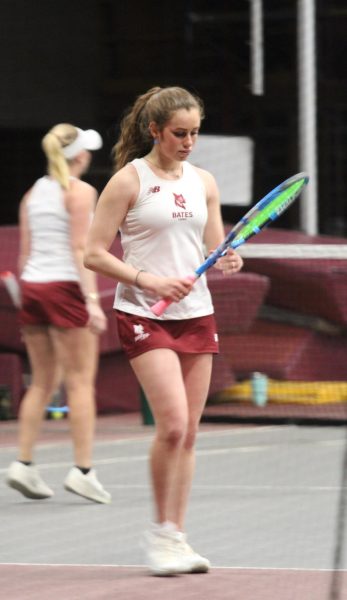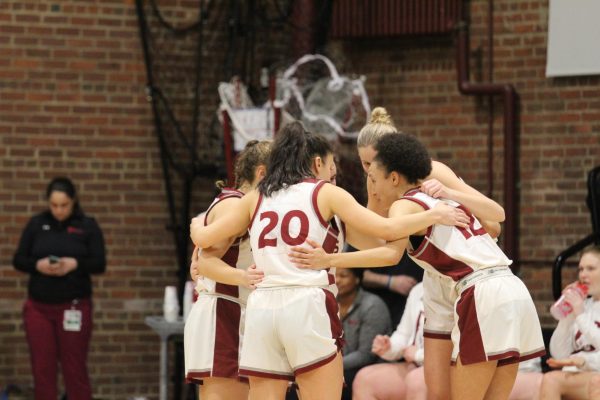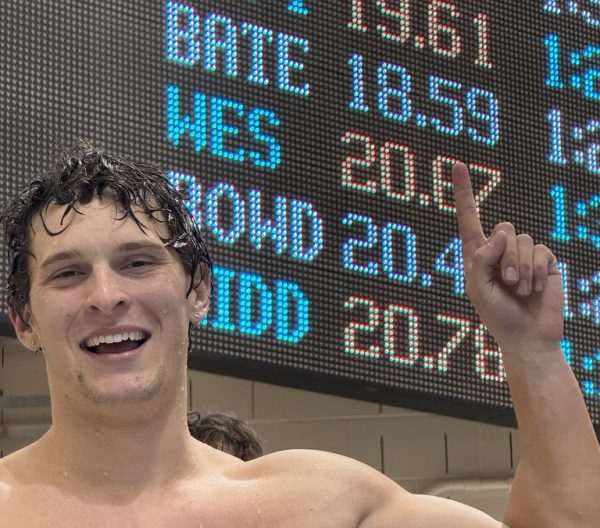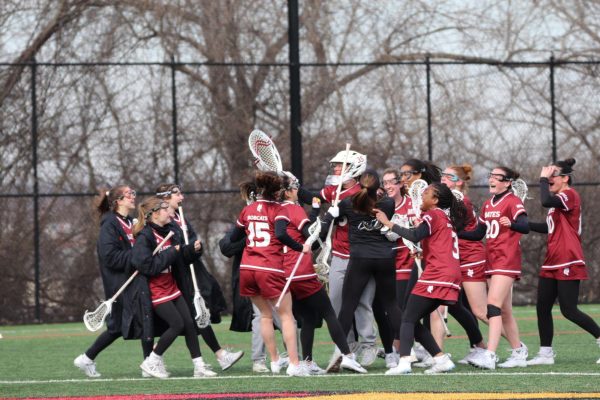Athlete recruitment: A complicated and confidential process
Introduction
College athletics is an incredible source of energy and excitement. From the booming Division I football stadiums, to the raucous Alumni Gymnasium, college sports are undoubtedly an important component of college life. But how exactly do these athletic teams form at academic institutions? In this feature, we examine different aspects of the college recruitment and admission process as it pertains to student-athletes, first by examining recruitment in the NESCAC, then through looking at Bates specific policies, and finally by examining Bates’ institutional philosophy on student-athlete recruitment.
Recruiting throughout the NESCAC
Student-athlete recruiting is an aspect of college admissions in all three NCAA Divisions. For Division I schools, sports are a huge source of revenue, and as such require admittance of quality student-athletes that will continue to ensure athletic success. Although not nearly as large a financial commitment compared to DI schools, at a NESCAC institution like Bates, athletics are an integral part of the campus environment. “The reality is that we have 31 varsity teams at Bates and that means in terms of fielding those teams, we as an institution have a commitment to doing that, and doing that with success,” said Dean of Admission Leigh Weisenburger in an interview with The Student.
The NESCAC is one of the premier Division III athletic conferences in the country, with a collection of 11 liberal arts colleges dedicated to both academic and athletic excellence. On the NESCAC website, the conference describes its mission as being, “committed to establishing common practices to keep athletics strong and in proportion to the overall academic mission of the member institutions.” All NESCAC schools do not give athletic scholarships, and the admissions offices alone can render decisions of acceptance. All student-athletes are required to complete their application in full, the same as any other applicant.
In her interview, Dean Weisenburger declined to comment on how the admissions office at Bates specifically goes about admitting recruited student-athletes, citing Admission and NESCAC policy.
The NESCAC does not officially publish how this process works on their website either. However, in 2005 the New York Times published an article about the NESCAC’s process of admitting student-athletes. The system reportedly establishes a slot system for recruiting student-athletes.
This slot system allows for schools in the NESCAC to admit a certain number of students who plan to participate in athletics and fall slightly below institutional academic standards for admittance.
In the Times article, the slot system is described as working like this: Each NESCAC institution is given two slots per varsity sport, with the exception of football, which is allotted 14 slots. At Bates there are 31 varsity sports, which would put Bates’ number of slots at 74, with 14 slots for football and 60 slots for the 30 other teams. It is at the discretion of each member institution in the NESCAC as to whether these slots are shared between different teams as they are needed year to year, or if each team is capped at two slots per year with the exception of football.
In addition to this slot-system, schools can establish a tier system to classify potential student-athletes, according to the Times article. The first tier is for student-athletes whose academic resume meets the regular admission standards of the school. These students would be competitive for acceptance regardless of their status as a student-athlete. The second tier classifies recruits whose academic resume falls slightly below admission standards and the third tier for those who fall substantially below. What these classifications are exactly in terms of GPA and test scores depends on the college, according to the Times.
Coaches then have the opportunity to use their allotted slots on potential student-athletes who fit within any of the tiers, typically within the second or third, to increase the chances of admission. Student-athletes who do not mean the minimum criteria for the third tier will not be admitted.
When asked about the tier process of student-athlete recruitment, Dean Weisenburger declined to comment, citing NESCAC and college policy. “That would just lend itself to other elements of the admission process that are confidential.”
In the 2005 Times piece, Amherst Dean of Admissions Tom Parker, who retired in June 2014 after 15 years at the college, stated, “The real danger was in not acknowledging that we give preferential treatment to student-athletes. It engendered a corrosive cynicism. When it was on the table exactly what we do, it wasn’t as bad as some faculty thought.”
Bates-specific policies
The recruiting process for Bates athletics centers on communication between the recruit, the athletic department, and admissions. In order to keep tabs on student-athletes across the globe, the athletic department and admissions rely on team liaisons.
According to Athletic Director Kevin McHugh, generally “three or four” sports are assigned to each liaison, which are tasked with getting a feel of prospective student-athletes. Weisenburger explains that the job of liaisons is to, “know the priorities and needs of their [assigned] team and make sure they’re articulating that to [the admission] committee.” Arts, international students, and geographic regions also have admissions liaisons.
These needs and priorities could range from outfield spots on the baseball team to needing a “libero,” a defensive specialist on a volleyball team, as Wiesenberger specifically noted. From there, the level to which a student-athlete can immediately contribute to Bates athletics is integral to the recruiting process, and is evaluated through their athlete rating system.
The system that the college puts into practice is a “1,2,3” system for athlete ratings. According to McHugh, “a one-rated athlete is someone that’s going to come in and make an immediate impact; you’re recruiting one-rated athletes.” He added that, “a two-rated athlete is typically someone that you’d like to have on a team, but they’re not necessarily going to make an impact right away.” A three-rated athlete would not be recruited by Bates athletics.
This past recruiting season, a minimum of 165 and a maximum of 210 student-athletes figured into this system according to McHugh, out of about a class of 500 prospective students.
The rating system, which McHugh noted is “strictly an athletic rating,” is especially prevalent in the early decision process. Although a prospective athlete does not need to meet an “academic standard to receive that rating,” according to McHugh, “the whole premise of ED [early decision] is that you’re basically guaranteeing a yield” on a large number of the total class of 165 admitted recruits. For a one-rated athlete who meets the academic guidelines from the tier system, getting denied ED1 at Bates is “fairly rare.”
However, with its academic rigors and assertiveness for finding students that fit the Bates culture, there are many factors other than numbers that play into the recruitment process. Before even going after an athlete, admissions gets an “early read” on high school athletes that are entering their senior year. McHugh explains that this read comes after July 1st and allows Bates to get sense of what their senior classes are like and what their junior grades are.
From there, if mutual interest exists, prospective student-athletes can arrange visits to the Bates campus and usually meet with coaches and the team. All of this happens without financial help from Bates. McHugh explains that the school can, “reimburse a coach for mileage and meals,” but cannot “pay for their [a recruit] transportation to Bates,” per NESCAC rules.
When attempting to delve into the specifics of recruiting for a sports team here at Bates, head women’s basketball coach Jim Murphy told The Student that McHugh informed coaches not to communicate with Student editors on the issue. Murphy did not refer editors to the college’s communication office.
NESCAC coaches have been more active in recruiting younger high school athletes, particularly freshmen and sophomores who are not cut out for the Division I level of lacrosse. This is due to the NESCAC moving the contact period from the end of an athlete’s junior year to the summer of their sophomore year. Contact, as defined by the NESCAC, limits coaches to attending camps and games. NESCAC coaches cannot make home or school visits.
To prevent recruits from slipping to other NESCAC rivals, coaches typically keep tabs on these athletes by phone and email. McHugh explains that, from this standpoint, “you are still keeping in touch and you are actively recruiting.”
The pool for prospective student-athletes is an ever-shifting landscape, mainly due to the fact that most Division III institutions require SAT scores, while a college like Bates does not. Getting an early read is pivotal for both Admissions and the Athletic Department, but can be a challenge because, according to McHugh, without requiring SAT scores, “it is a little bit tougher on us, because we can’t get as hard a read as soon as we would like.”
Still, potential student-athletes who are strong academically but with low test scores have SAT optional schools like Bates and Bowdoin as an additional option. To McHugh, this “let’s us get involved with some kids that other schools can’t, so it is really cut both ways.”
Though it is clear Bates’ SAT optional policy opens doors for athletes, recruiting can be a challenging process. With NESCAC limitations making it difficult for coaches to scour the country, they make every effort to keep in contact.
Furthermore, the early read and athlete-rating system processes attempt to satisfy the goals of Admissions, and attract student-athletes to Bates that will contribute academically and athletically. For teams like men’s basketball, swimming, squash, and track, Weisenburger notes that their recent postseason success will hopefully be a “point of aspiration” for student-athletes in the future.
The Bates Philosophy
As an institution, Bates has an underlying philosophy that influences the recruiting process. In Weisenburger’s 11 years at Bates, she has worked to reshape the perception of the athletics program.
She hopes to keep moving towards, “a shift in mindset and making sure that we continue to talk about those who happen to play sports as student-athletes, and not just strictly as athletes. I think that’s fair to them; I think that’s the truth. Their absolute identity is both, not just one or the other, and I think they deserve that, and we as a community owe it to ourselves and them to recognize they’re here for a multitude of reasons, not just for athletics.”
When it comes to filling Bates’ freshman class of approximately 500 students, Weisenburger said that, “College admission is an art not a science,” and emphasized, “in regards to admissions, we can’t have quotas.” Nevertheless, Bates Admissions realizes the importance of filling teams with competitive athletes.
But in this respect, Weisenburger believes that athletics is not unique. “Recruitment falls under a larger umbrella of making sure our students have opportunities to explore a number of their passions while here at Bates, not just athletics,” she said.
According to McHugh, success for Bates athletics can also help the overall prestige of the school, especially in regards to attracting a diverse mix of students. “I think recruitment is huge [for drawing students to Bates]. We’re helping the college meet its goals, certainly with the athletics piece, the diversity piece- I think we’ve made good strides over the last few years, not only with racial/ethnic diversity, but also socioeconomic diversity, and expanding outside New England. So we’re aligning our goals with what the admissions goals are too.”
Weisenburger added that, “Athletics travels, much like our debate team travels, and so when you are out and about representing the college, and doing so in a positive way, that helps the institution tremendously, in terms of drawing students who might have an interest not just in athletics, but in Bates at large.”
Internally, Admissions is committed to bringing in a vibrant freshman class with a variety of talents and the ability to make positive contributions to the Bates community. With recruited athletes in particular, this means, “we’re not simply rating or admitting them based on their athletic ability, because we need to make sure they will succeed in all facets of life at Bates, not just athletics.”
In recent years, many Bates student-athletes have earned NESCAC All-Academic accolades. This honor is awarded to varsity athletes who have reached sophomore academic standing and have a cumulative GPA of at least 3.35. The spring 2014 total of 92 NESCAC All-Academic award winners set a Bates record. This year, 49 and 72 student-athletes were NESCAC All-Academic in the fall and winter seasons respectively.
Other than publicizing awards, Bates has a policy of confidentiality regarding any kind of demographic breakdowns as far as academic performance is concerned, including between athletes and non-athletes. Over one third of the Bates student body plays at least one varsity sport.
Media Relations Director Kent Fischer explained this institutional policy: “It [publishing data on student-athletes’ academic performance] opens the door to what about artists, what about biology majors?” He continued, “I’m not saying that’s what would happen, but you get to point where the end value is so small you start to sort of identify. The big takeaway is the vast majority of students at Bates graduate.”
Institutions that give athletic scholarships are required to make available graduation rates by sport under Title 1, Section 103 of the Student Right-to-Know Act. Division III has no such stipulation.
McHugh was willing to divulge details on the academic performance of student-athletes, although he also did not provide any specific data: “The Admissions and Financial Aid Committee looked at athlete academic performance a couple years ago,” he said. “The problem was the college changed their whole rating system. Basically what they found was if you look at first-year athletes compared to non-athletes, there’s a pretty significant gap. But by the time they get to their junior, senior year, the athletes have made up that gap, and there’s really not a significant difference,” McHugh said.
“We haven’t run those numbers in a while; I would say it’s the same now, if not a little better. It’s not really surprising that in the first year it takes time to adjust to playing college level athletics and balancing that with academics…I would suspect that being part of a team and having that additional support probably offsets the time commitment,” McHugh concluded.
Weisenburger, who played varsity field hockey and lacrosse in college, summed up her feelings on Bates’ approach to student-athletes: “I personally really value the student athletic experience. I did not see myself as an athlete first, and I think that it’s a point of pride for the institution. Those accolades are a point of inspiration and something to be proud of as much as our debate team killing it across the globe; those achievements are something to be proud of just as much as our Fulbright’s are and beyond.”
Conclusion
Student-athletes make up over a third of the Bates student body. Due to the competitive environment of student-athlete recruitment, many institutions are reticent to provide information on the process. Both the NESCAC and Bates have certain policies that create an environment of stringent confidentiality surrounding recruitment procedures. We hope this piece helped to illuminate this complicated process. There are certain aspects of the student-athlete recruitment process where Bates believes that complete transparency is not the best option.
Your donation will support the student journalists of Bates College and help us cover our annual website hosting costs.







